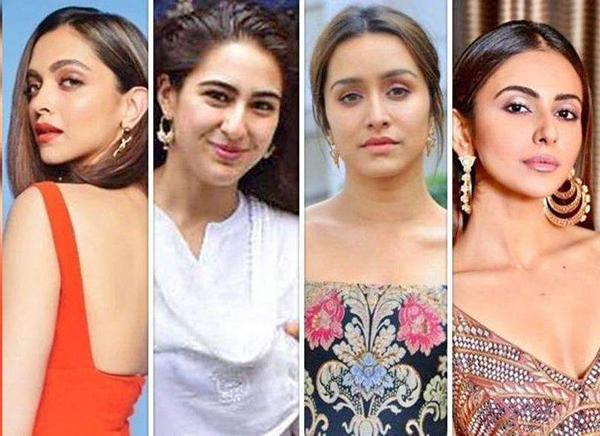
Where glamour & money are honey; criminals are bees
A nation’s security is a fickle phenomenon. India is that juicy plum, the Islamists have been fruitlessly trying to pluck for over a thousand years now. Having failed with the sword, they have turned to economical, educational and indoctrinational methods. These are innocuous and apparently harmless activities designed to destabilise and disintegrate India. These are smartly cloaked to evade public attention. Like the hour hand of a clock, that appears stationary but is moving all the time, these activities are not noticeable until they are too late to remedy. The unnatural and shocking death of actor, Sushant Singh Rajput and the emerging machinations of Bollywood mafia with the tacit abetment of state government has opened an overflowing can of worms. The tectonic fallout of this event will have far-reaching results and may even bring down the government in Maharashtra.
Cinema is considered a mirror of society. In India, however, cinema has not so much reflected society as it has shaped and altered it. A nation’s psyche is as intimately linked to a nation’s security as ego is hitched to power. Cinema is a huge commercial cow too, providing fame and moolah of Rs 1,650 crore yearly (2018) to those involved in film-making. Its reach is far and wide with movies in 23 languages penetrating every nook and corner of India. Where trade is a religion; profit invariably becomes God !!
Teaching By Narrative
One of the most surreptitious and effective methods of teaching is through narrative, ie, via story-telling, plays, novels, movies, etc. This learning is far more effective than through any classroom lecture. Of these, cinema and TV are, by far, the most effective as they teach while entertaining, a powerful combination. The power of visual-media in shaping the mind is profound and surprisingly under-rated. Courtesy Bollywood, Hindi is largely understood in most parts of non-Hindi speaking regions of India. Even devout opposers of Hindi willingly watch Hindi cinema and inadvertently pick-up the language – something no act of parliament could expect to do. (Here, Bollywood is used in a generic sense and includes Indian cinema of all languages and regions).
Impact on Security
How can films and mass-media affect India’s security? The biggest threat to India’s security is her potential loss of Hindu identity, via Islamisation and Communism. No nation is as ashamed of its religious identity as India is of Hinduism. India is as much a Hindu nation as USA is Christian and Saudi Arabia is Islamic. India was partitioned on religious grounds – India for Hindus and Pakistan for Muslims – to satisfy the ambition of three Muslim cousins, who each wanted to be prime minister of independent India. Nehru, with the copious advantage of a Hindu name, got India; Jinnah got the smaller Pakistan and Sheikh Abdullah had to be content with an autonomous Kashmir. Their descendants have pursued the goal of Islamising India, with the tacit support of the comity of Muslim nations. Similarly, China, that views India as its sole regional competition, is determined to undermine India’s Hindu identity through Communism, peddled via its strongholds in West Bengal and Kerala. Success of either Islam or Communism will spell the death knell of India as a nation. India may de jure be a secular nation, de facto she is a torchbearer of Hinduism and abode of the Hindus for over 5,000 years, surrounded by nations converted to Islam via the sword. China’s ire with India is irreligious and fulcrumed on Asian leadership. Both, Pakistan and China, are convinced India can be subjugated only by annihilating her Hindu culture. So, their target is mockery and denigration of Hindu rites, rituals and practices. While Pakistan has taken the filmy route, China has focussed on economic, political and military onslaught.
Genesis of Muslim Dominance
The seeds of surreptitious Islamisation of India were sown in 1926 through the creation of Tableeghi Jamat in New Delhi. The Jamat was tasked to quietly unite and prepare the Muslims for takeover of India through mass erection of mosques, forcible conversions, marriage with Hindu girls (love jihad), creating ever increasing pockets of Muslim strongholds and physically evicting or eliminating Hindus. This was most remarkably successful in Kashmir, Punjab and Bengal along with the Awadh region of UP, which had immense Muslim influence in society. Ironically, these regions happened to be the pioneers in Indian film industry. Prominent Hindus of these regions followed the Ganga-Jamuni tahzeeb – a one-way traffic of Hindus celebrating Muslim way of life while not getting any reciprocal response from the Muslims. This tahzeeb sowed the seeds of Muslim dominance in Bollywood, whose roots, over time, have spread wide and deep. Earlier, Muslims were loath to use their Muslim identity, hiding behind Hindu names. That cloak has come off ever since blood-money of Pakistan-based drug-smuggling-prostitution-extortion mafia came into Bollywood in the 1970s. Today, Muslims flaunt their surnames with aplomb and dominate the film industry. The apparently Hindu tycoons of Bollywood, viz, the Kapoors, Johars, Bhatts, etc, are themselves more Muslim than Hindu through marriages and affiliations. Their surnames – an effective camouflage of their identity and intent.
ALSO READ: Pandemic : Tablighi Jamaat And India’s Security
Though Islam scoffs at music and dance, except in praise of Allah (Ishq-e-Haqiqi), Bollywood has been flooded with Muslims. Dada Saheb Phalke may have pioneered film-making in India, it was Ardeshir Irani who blazed the path with Alam Ara, the first talkie. Muslim producers, directors, actors, actresses and music directors have dominated the field out of all proportion to their population in India, viz, Mehboob Khan, KA Abbas, Kamal Amrohi, Abrar Alvi, Abdul Rashid Kardar, Saadat Hassan Manto, Ismat Chugtai, Ghulam Haider, Khayyam, Sahir Ludhianvi, Majrooh Sultanpuri, Shakeel Badayuni, Mohammed Rafi, Talat Mahmood, Shamshad Begum, Dilip Kumar, Meena Kumari, Madhubala, Johnny Walker, Mehmood, Rahman, etc, to name some pioneers. Zealous nepotism has ensured the continuance of their breed to the modern-day.
Bollywood has evolved an entire genre, “Muslim Social”, devoted to promoting superiority of Muslim culture. It started in the 1950s, focussing on the life of the Muslim elite. Films were made about the Mughals – Humayun (1945) by Mehboob Khan, Shahjehan (1946) by Abdul Rashid Kardar, Mughal-e-Azam (1960) by K Asif, Taj Mahal (1963) by M Sadiq and Jahan Ara (1964). Another popular theme was the nawabi culture of Awadh (Lucknow), marked by elaborate production and music, highlighting the sophistication of language and lifestyle of Muslims, like Mirza Ghalib (1954), Chaudhvin Ka Chand (1960), Mere Mehboob (1963), Dil Hi To Hai (1963) and Pakeezah (1972) by Kamal Amrohi. This was in sharp contrast to that time’s cinema that projected the trials and tribulations of poor and the under-privileged Hindus through Mother India, Pyaasa, Do Bigah Zamin, Boot Polish, etc. There was no riposte from the Hindus by way of Hindu Social cinema. The Muslim Social cinema was embraced by India as reflective of her secular and tolerant fabric. This was later to be exploited by the Islamic fundamentalist dons, both in India and abroad, to not just boost Muslim culture, but to also denigrate Hindus in a camouflaged fashion. Here, cinema was not reflecting society as much as trying to influence it through indoctrination. Muslims were shown rich and powerful and Hindus as poor and helpless, somewhat like a white crow and black snow.
Threat From Pakistan
Film-making requires a lot of money. There is a lot of money in crime – smuggling, extortion, drugs, prostitution and hawala, etc. Criminal dons with easy moolah found a convenient vent in Bollywood for converting the colour of their blood-money to a pious white. This brought them power in the film world besides glitz, glamour and girls, for their personal gratification. Soon, money-power resulted in Pakistani dons influencing the story, screenplay, casting, set-design, music and direction of Indian movies. Openings for Pakistani actors and singers became a necessity. All the perps, rascals, scalawags, varlets and rogues had to have pious Hindu names like Seth Dharamdas, Dharma, Kishna, Ram Bharose, etc, and all the good Samaritans, the sacrificers, the do-gooders and the selfless martyrs had to have Muslim names like Khan Chacha, Abdul, Mustafa, etc. Hindu temples were shown hiding criminal cash (Hera-Pheri) while mosques symbolized hope and piety. Songs to Maula answered all prayers while Bhagwan was no good.
ALSO READ: CAA, NRC and India’s Security
In the last 70 years, not a single movie has been made depicting life of a poor Muslim family or on Muslim taboos like triple talaq, halala or polygamy or where a Muslim character has been a villain. If an odd movie, like Nikaah, on the evils of triple talaq, saw the light of day, the careers of its cast perished. Even notorious criminals like Allaudin Khilji have been romanticised by no less an actor than A-lister Ranveer Singh, in Padmavat. Indian movie-makers do not have the gall to portray any Muslim in bad light. They can, however, sully Radha, the courtesan of Lord Krishna and one of the most worshipped devis of Hindus, as some street harlot in the song Radha Teri Chunri (Student of the Year) describing her thumka and sexy body rather lewdly. A similar song on Virgin Mary or Fatimah, the daughter of Prophet Muhammad, the closest a Muslim woman can come to adulation, would result in certain genocide. It is intriguing that there is not a single villain in Indian film industry with a Muslim name. Hamid Ali Khan adopted the screen-name Ajit to enact villainous roles. Villainous roles by Muslims have been on a grand, almost heroic, scale like Amjad Khan’s Gabbar or Emraan Hashmi’s Gangster. Crimes like murder, rape, molestation, embezzlement, etc, are the preserve of Hindu actors.
Film industry is now divided into two verticals: those owing allegiance to the dons and the others. The former, being more powerful, call the shots in loaded movie scripts, unfair awards functions, biased film critiques and ratings, partial film magazines and filmy functions. Consequently, film careers of the faithful soar, whilst those of the others, even if better, nosedive. The Khans, the Kapoors and the Johars are supremos and the Ranauts, the Rajputs and their ilk must suffer. Those, like Bharati, Sridevi, Jia Khan, Disha Salian, Sushant Singh Rajput, etc, who opposed or became aware of the dirty tricks of the faithfuls were systematically eliminated. The outreach of the dons extends to the state police and the local government who abet and connive at all the wrongdoings of this mafia. The current furore in the Sushant Singh Rajput-Rhea Chakravarty-Kangana Ranaut imbroglio is but a tip of the Bollywood-Pakistan crimeberg.
Future Threat From China
China is the largest movie consumer of the world. By 2026, it is expected to hold 40-50 per cent of global market share of box-office. It holds the global weekly box-office record of US $557 million in tickets since Feb 2016. No wonder, Hollywood panders to Chinese audiences and censors. So far, China has focussed only on Hollywood; arm-twisting the American producers and distributors into adapting their screenplays to suit Chinese government policies. Chinese companies are investing and brazenly controlling film production in Hollywood. Now, there can be no reference to Taiwan and Tibet as China does not believe in their separate existence. Japan cannot be shown in good light as China abhors Japanese domination of China of the past. Villains can no longer have Mongoloid features. Chinese can only be shown as good Samaritans and performing heroic acts, as in Gravity, disaster movie 2012, Doctor Strange, etc. China must be portrayed as a benign country, as normal as any Western nation. USA has readily capitulated as the Chinese moolah is too lucrative to ignore. The film career of an actor no less than Richard Gere has been finished, thanks to Chinese boycott of his films ever since his affinity to the Dalai Lama became public.
The recent success of Hindi films in China – PK, 3 Idiots and Dangal – proves China’s next target is bound to be India, the largest movie producer in the world. Using its strongholds, West Bengal and Kerala, as launch pads, China can influence and control movie-making in India. This is a serious threat to India’s potential communist indoctrination. There is unlikely to be any resistance from the moolah-driven film industry. The onus is on Indian government to recognise this threat and take preventive measures, as it has done against Chinese apps and Chinese imports.
China and India are engaged in a wary competition for regional leadership. But more and more, the two Asian giants are competing to project soft power — cultural influence — outside their borders. The success of Dangal has raised concerns in China that it is falling behind. China’s development has been very comprehensive in terms of politics, economics and military but in terms of soft power, India has done better through her emphasis on promoting her culture, like yoga, Buddhism, Ayurveda and Bhagvad Gita.
The Remedy
Not much can be expected from the film industry where box-office rules the roost and blood-money finances film-making. Central and state governments must devise methods to plug the ingestion of black money into filmdom. It may be easier to contain Chinese influence as it comes via their government-controlled and identifiable companies. Curbs on cash inflows from China and ban of known film-finance corporations of China could be undertaken.
The Pakistan-Dubai influence is more difficult to tackle, largely due to the ethnic affinity of the Punjabis, Bengalis and Awadhis, among others, with the culprits. Here, it is essential for Hindu organisations like Karni Sena, Vishwa Hindu Parishad (VHP), Bajrang Dal, etc, to play a role in education and awakening the population against loaded films.
The most potent tool available with the government is, of course, the Central Board of Film Certification (CBFC). It should be manned by diligent and sincere nationalists who can censor camouflaged and contrived agenda from the movies. Sex, nudity and violence are not as damaging to society as indoctrinating propaganda projected on the screen, without so much as a kiss.
The ultimate weapon is certainly in the hands of the movie-goer. No mafia can counter boycott of a film by the public. Awareness is slowly but surely growing in this direction as exemplified by the discard of recent movies of Deepika Padukone and Salman Khan recently.
Postscript
There is no better example of cinema turning a narrative on its head than the Samar Khan directed Shaurya (2008) in which Kay Kay Menon’s heartfelt angst against widespread Muslim atrocities against innocent Hindus seems overly villainous while a Hindu Army officer’s cold-blooded murder by a Muslim colleague is made amply heroic. This modus operandi has been used repeatedly in Indian films.

















